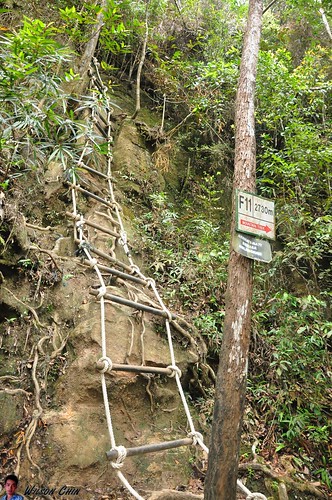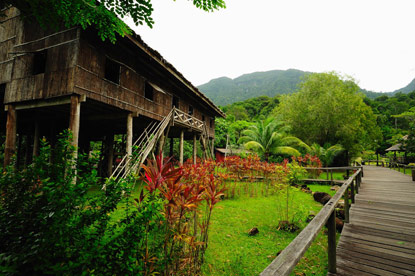Interesting places in Kuching
1. Mount Santubong
2. Gunung Gading National Park
3. Kuching Waterfront
4. Sarawak Cultural Village
1. Mount Santubong
History
Excavations of the surrounding area uncovered Hindu and Buddhist relics from the 9th Century CE. Song and Tang dynasty ceramics are also found, indicating that the area around the mountain was a trading port from the 11th to 13th century.
Legend
A legend often associated with the mountain is of two beautiful princesses, Santubong and Sejinjang. Santubong was an expert weaver while Sejinjang was an excellent rice tresher. One day, they had a quarrel and exchanged blows. Sejinjang swung her tresher which hit Santubong's cheek. Santubong threw her weaver at Sejinjang, hitting her in the head. Putting an end to the quarrel, the King of Heaven cursed both of them into mountains. Santubong turned into Mount Santubong while Sejinjang was turned into Mount Sejinjang. It is said that Mount Santubong resembles a woman lying on her back.
Mount climbing

Start the climb slowing at first and enjoy the amazing nature and the sound of the tropical jungle and mountain stream, to get your body into rhythm with the ascent. Ropes are strung along difficult and steep stretches, and often you have to clamber over huge uneven boulders the size of chairs or even bigger. On rainy days, these boulders, often covered with moss, are treacherously slippery. At the final approach to the summit, the ascent is practically perpendicular, but ladder are strung, it is like rock climbing.
2. Gunung Gading National Park
Gunung Gading national Park is located in the Lundu District, southwest of sarawak. The Park consists of rugged mountain peaks which provides a scenic backdrop to the nearby beaches at Pandan and Siar. The waterfalls in the upper reaches of Sungai Lundu have become a popular recreational destination for both local and foreign visitors. The more adventurous visitors can take a hike right up to the peak of Mount Gading which is 900 meters high.
Rafflesia Flowers At Gunung Gading National Park
The rare rafflesia flower,often mistaken as the largest flower in the world, is actually the heaviest. The rafflesia attracts flies along with day-trippers from Kuching when in bloom. According to the park’s official board, only a small number of either local or foreign visitors decide to stay overnight in the national park. Unlike Bako National Park, Gunung Gading National Park is the perfect place to hide from the crowds and explore some of Borneo’s natural wonders!
The rafflesia flower blooms unpredictably and has a brief flowering period; there is no way to time your trip according to the flower – it takes a bit of luck. Check with Sarawak Forestry Office in Kuching; the rangers stay in-the-know about flower timing. The friendly rangers in the office are proud of their foul-smelling flower and will be happy to assist you.
Waterfall
Trekking
Hiking in Gunung Gading National Park is mainly along one main trail; smaller trails branch off to suit every fitness level. The main trail becomes steeper and more difficult to navigate as you approach the summit of Gunung Gading.
The beauty of Gunung Gading National Park is that you do not need to hire any guide; you can take your own time and go at your own pace to explore. Disregard what the official website and brochures in Kuching say –you DO NOT need a guide to go trekking in Gunung Gading National Park.
The treks are well marked so there is no chance to get lost. Bring plenty of water and some snacks.
A relatively easy, two-hour trek through the valley from the top of the summit will bring you to Batu Berkubu, a massive, sheltered rock that once served as a communist based camp.
Please do not forget that it gets dark relatively early in the rainforest; allow enough time for your return back to the park HQ and carry a torch!
The Night Trail is great fun and an adventurous way to spend evenings in the Gunung Gading National Park. Switch off the torch, find a comfortable spot to sit, and listen to the night sounds of the rainforest as shiny eyes watch.
3. Kuching Waterfront
 Aptly called The People Place, Kuching Waterfront was built for the people of Sarawak and visitors alike. It is their place to enjoy, to entertain and be entertained. A heritage to be proud of, and a legacy to pass on to generations to come. Stretching approximately 1 km, with a riverside walk linking the hotel precinct with downtown Kuching, the Waterfront is 'self-contained' with facilities for entertainment, refreshment, relaxation, cultural enjoyment and arts appreciation. It is also a great place for family gatherings, corporate outings and school and community projects.
Aptly called The People Place, Kuching Waterfront was built for the people of Sarawak and visitors alike. It is their place to enjoy, to entertain and be entertained. A heritage to be proud of, and a legacy to pass on to generations to come. Stretching approximately 1 km, with a riverside walk linking the hotel precinct with downtown Kuching, the Waterfront is 'self-contained' with facilities for entertainment, refreshment, relaxation, cultural enjoyment and arts appreciation. It is also a great place for family gatherings, corporate outings and school and community projects.
Coolies bustling over berthed junks. Hawking of wares, Indian chettiars haggling. Natives selling jungle produce. That was Sarawak River to Kuching. Then time intervened. Sarawak River was not what it used to be. Quietness settled in. The godowns deserted, the merchants shifted.
History
 Kuching Waterfront was rebuilt to return the frontage to the people. Officially opened in 1993, it spans 890 metres, each step rich in local history and culture. Structures are preserved. The frame of the amphitheatre was originally part of a godown built in 1929. Other testimonies of this endeavour are the buildings of Sarawak Steamship Company and Chinese Museum. Tradition radiates from the Chinese Pavillion. Each step of the way is paved with mosaic panels depicting ethnic motifs. Kuching of by-gone days is revealed on plaques along the promenade floor. Trace the White Rajah’s reign. Read about rebellions and piracy.
Kuching Waterfront was rebuilt to return the frontage to the people. Officially opened in 1993, it spans 890 metres, each step rich in local history and culture. Structures are preserved. The frame of the amphitheatre was originally part of a godown built in 1929. Other testimonies of this endeavour are the buildings of Sarawak Steamship Company and Chinese Museum. Tradition radiates from the Chinese Pavillion. Each step of the way is paved with mosaic panels depicting ethnic motifs. Kuching of by-gone days is revealed on plaques along the promenade floor. Trace the White Rajah’s reign. Read about rebellions and piracy.Sampan (Tambang)
Monthly Dance and Music Performance
 Rounding up the 4th Sunday of each month, the dancer groups will be strutting their multi-ethnic diversity of Sarawak at the Godown Amphitheater Kuching Waterfront between 8:00pm - 9:00pm. The main routines will be focused on ethnic and traditional dances using their individual costumes accompanied by music and audience are encouraged to participate by joining in the dance!
Rounding up the 4th Sunday of each month, the dancer groups will be strutting their multi-ethnic diversity of Sarawak at the Godown Amphitheater Kuching Waterfront between 8:00pm - 9:00pm. The main routines will be focused on ethnic and traditional dances using their individual costumes accompanied by music and audience are encouraged to participate by joining in the dance!The busy weekly schedules to expose the artistic talents of Sarawak are part of the efforts to bring up a generation of artists and enhance the appreciation of local cultures and ethnic traditions. These will lead to better understanding of the arts and crafts, cultures of Malaysia locally and also among visitors.
4. Sarawak Cultural Village
 Sarawak Cultural Village is one of the must see attractions here in Kuching Sarawak, simply because it is one of a kind Living Museum in the world. It is located at the base of the legendary Mount Santubong and only a few minutes walk away from Damai Beach Resort.
Sarawak Cultural Village is one of the must see attractions here in Kuching Sarawak, simply because it is one of a kind Living Museum in the world. It is located at the base of the legendary Mount Santubong and only a few minutes walk away from Damai Beach Resort.Sarawak Cultural Village is roughly 35KM from Kuching town and if you’re driving, it will take 45-50 minutes to get there. Sarawak Cultural Village is an Award Winning cultural showcase and it is also the venue for the yearly World Harvest Festival and theRainforest World Music Festival (held in July or August).
About Sarawak Cultural Village
Here, it is possible to see Sarawak's ethnic diversity at a glance. The handicraft is both bewildering and tempting, including the Kain Songket (Malay cloth with gold inlay), Pua Kumbu (Iban housewives textiles), Melanau Terendak (sunhat), Bidayuh tambok (basket), Iban parang (swords), Orang Ulu wood carving and Chinese ceramics.
Performance
The 45-minute cultural performance of songs, dances and entertainment is something you will not want to miss during your visit to Sarawak.